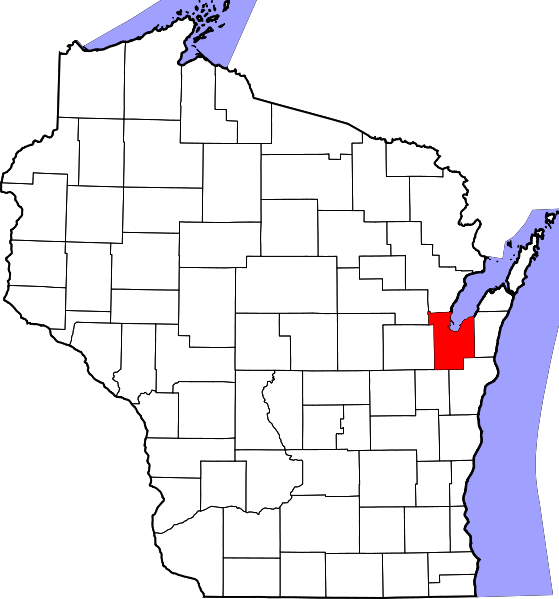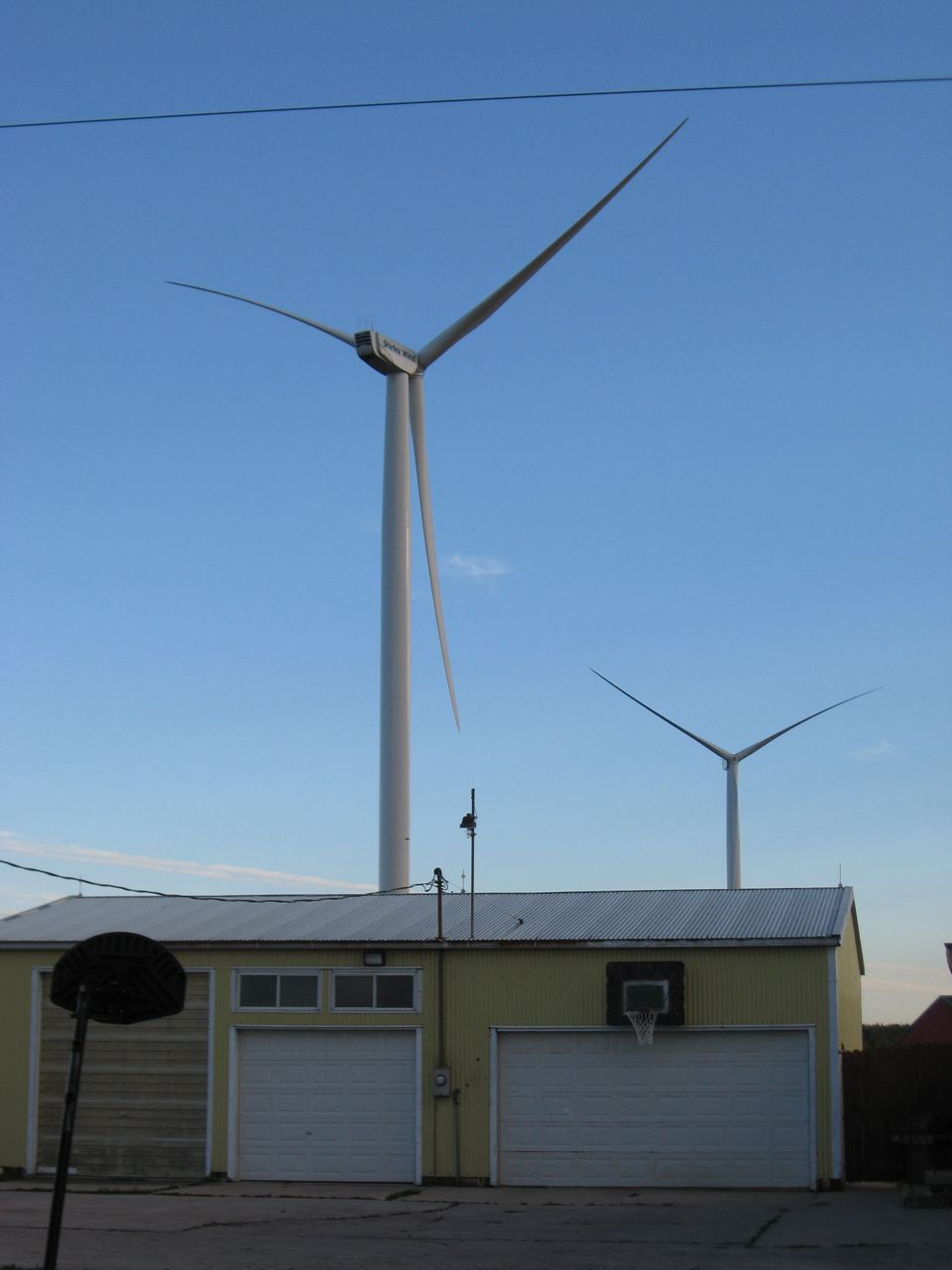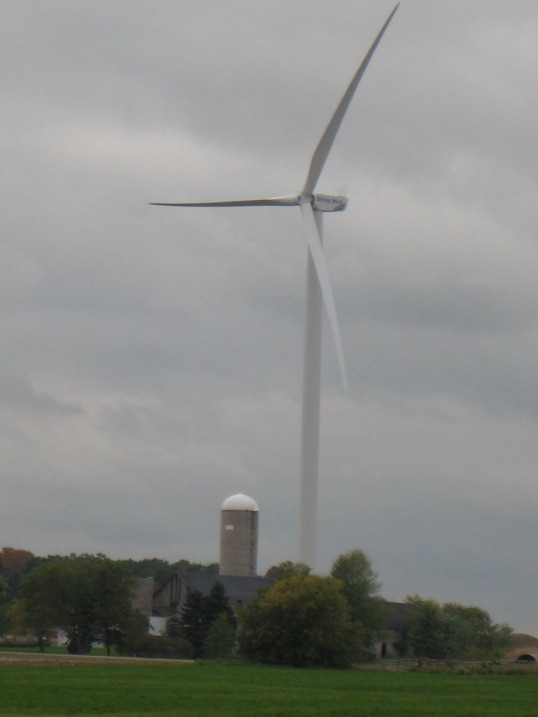Wind Fight Keeps on in Morrow County
SOURCE: East Oregonian, www.eastoregonian.com
November 19, 2010
Erin Mills
IRRIGON — Both parties involved in the fight over noise from the Willow Creek Energy Center have again appealed a Morrow County Planning Commission ruling to the Morrow County Court.
The planning commission’s Oct. 26 ruling expanded on its earlier decision — also appealed to the county court — that found the wind project in violation of state noise rules and gave it six months to comply.
The company that owns the 48-turbine project, Invenergy, appealed the ruling because “the planning commission’s decision incorrectly construed the applicable noise standard and was not supported by substantial evidence in the record,” according to its appeal application.
The four neighbors who live near the project appealed the ruling because it did not immediately ensure compliance with the noise rule, particularly at night, and didn’t force Invenergy to pay for the neighbors’ noise study.
The Morrow County Court is scheduled to review the issue Dec. 8 at 10 a.m. at the Riverfront Center at the Port of Morrow.
SECOND FEATURE
BRUCE COUNTY COUNCIL BACKS CALL FOR TURBINE STUDY
SOURCE: The Sun Times, www.owensoundsuntimes.com
November 18, 2010
By Don Crosby,
Bruce County council is throwing its support behind a request from Huron-Kinloss that the Grey Bruce Health Unit study the health effects of wind turbines close to homes.
"I have a lot of people in my community that have been sick since the turbines [have been] up and working. We hope if we pass this resolution around to other municipalities we'll gain some support. Take this to the health board and hopefully Dr. [Hazel] Lynn will see fit to take it to the next level, whether that's a health study or whether it's getting other health units in other counties involved in this process," Huron-Kinloss Mayor Mitch Twolan said after Thursday's meeting of the county's agriculture, tourism and planning committee.
"I think it's very important that no further turbines are erected until some sort of health study is done."
Twolan said he knows of seven families who left their homes since 38 turbines became operational in the Ripley area.
There are proposals for another 50 turbines in Huron-Kinloss and Twolan said he's hearing of other people who say they are affected but haven't said anything.
"There is a silent majority out there that have not come forward to state their concerns because they don't want it to be public. So in the best interest of all our people in all of our municipalities I think this is very important," he said.
Kincardine Mayor Larry Kraemer, who has long been on the health unit's board of directors, said he doesn't believe the medical officer of health can undertake this kind of study herself, but voted to support the Huron-Kinloss resolution.
Lynn earlier this year called on the provincial government to conduct studies to clear up claims of people who say they are suffering from living too close to wind turbines.
Twolan said there is still too little information available to the general public and municipal leaders, who feel left out of the loop yet take the brunt of complaints.
"We're told in the Green Energy Act that everything is in order and in place, yet we have people sick in our community . . . I think it's incumbent on us as leaders at the municipal level to hear their concerns and take it to the next level," he said.
Twolan said energy companies have tried to solve the problems of the seven families who moved.
"In fairness to them they have tried to rectify the situation, but before we move forward in new proposals let's have all of the answers in place and these concerns addressed," he said.
Although Twolan was acclaimed as mayor in the recent election he says concerns about the effects of wind turbines on residents was uppermost in the minds of the electorate.
Residents have given him and his council a second chance, but expect them to do something about these concern, Twolan said.
"As long as you take the message to the next level people will listen. And I genuinely believe in my people. We have issues and we have concerns. The Green Energy Act and these wind turbines are more than just about green energy. There are people out there that are just not happy with this whole process," Twolan said.
Bruce County councillors voted unanimously to support the Huron-Kinloss resolution.
THIRD FEATURE:
IBERDROLA HALTS PLANS FOR WIND INDUSTRY FARM
SOURCE: Putnam County Sentinel, putnamsentinel.com
November 18, 2010
Marlena Ballinger, Managing Editor,
OTTAWA – According to an e-mail sent to the Putnam County Commissioners last week by CIC director Martin Kuhlman, the Wind Energy Project in Putnam County has come to a standstill.
Kuhlman stated in the email that Iberdrola is upset because a Sentinel reporter was present during a phone call between Iberdrola representative, Tim Lang and the Commissioners.
Before last Friday’s commissioner’s meeting, Van Buren Township trustee, Denny Schroeder spoke to commissioners, Travis Jerwers and Vince Schroeder regarding the proposed withdraw of Iberdrola. Commissioner John Love was in Columbus. Denny was basically upset because the commissioners refuse to accept the proposed $4200 per megawatt Iberdrola has agreed to pay.
The project would have generated about 150 megawatts resulting in a $630,000 annual payment from Iberdrola.
According to Senate Bill 232 a company wishing to build a wind energy farm is required to pay in lieu of taxes (PILOT) $6,000 to $8,000 per megawatt to the entities involved but not to exceed $9,000.
The entities involved in this project include Leipsic School district, Van Buren Township and the Putnam County Commissioners.
Over 15 years, the proposed $630,000 per year would be divided out via the school district receiving 72.9 percent, Putnam County receiving 15.3 percent and Van Buren township receiving 11.89 percent.
The commissioners stand alone in the fact they feel Iberdrola should have to abide by Senate Bill 232.
Van Buren township trustees and the school board are willing to go along with the offer presented to them from Iberdrola.
FOURTH FEATURE
WIND ENERGY, SOLAR POWER, FACE CLOUDY FUTURE
SOURCE CNNMoney.com, money.cnn.com
November 18 2010
By Steve Hargreaves, senior writer,
After years of rapid growth and darling status among many in Washington, the future of the American renewable energy industry is uncertain.
That’s because the government cash it has come to rely on may dry up on Dec. 31.
Before the Great Recession, renewable energy developments were helped by a tax credit, worth generally 30% of the cost of the project. When the recession hit, the stimulus package replaced those tax credits with direct cash grants of similar value. Cash is considered more beneficial than credit to the industry.
So far, the government has handed out about $5.4 billion, according to the Energy Department.
Congress could vote to extend the grants, but that’s highly unlikely.
If they’re allowed to expire, incentives for renewable energy will revert to the old tax credits.
“This is not a great place to be in,” said Denise Bode, head of the American Wind Energy Association. “It’s an economic opportunity that will be missed.”
The wind industry is already hurting — even with the cash.
The amount of new electricity wind can generate declined 72% in the third quarter compared to the same time last year, according to the wind association.
The wind industry isn’t the only one saying it will suffer.
Without the cash grant, “we’ll grow at a much smaller rate,” said Edward Fenster, CEO of Sunrun, a San Francisco-based company that installs solar panels on people’s homes.
“They’ve ensured that we’re building something new everyday,” he said
Sunrun has 7,000 customers in seven states. The company installs $1.1 million worth of new systems every day, employing 3,000 contractors.
Fenster said the cash grants let him get cheaper loans than the old tax credits, enabling him to reduce the price of the solar energy he sells by up to 25%. He predicts that price reduction would allow him to double his business next year.
But with “cut spending” the mantra on Capitol Hill, slower growth may be the new reality.
“On a gut level, a lot of the conservatives just don’t like to see the government handing out checks to people,” said Kevin Shaw, an energy lawyer at Mayer Brown. “I just don’t see the grant program being extended.”
But the White House does. The Obama administration has proposed a plan: Pay for it by using money left over from the stimulus package. That’s led some analysts to at least give it a shot at passing.
“You have a road map from the White House,” said Whitney Stanco, an energy analyst at the Washington Research Group. “And previously, Republicans have been amenable to using unspent stimulus funds to pay for other priorities.”
A spokesman for presumed Speaker of the House John Boehner wouldn’t get into details about what the incoming house might fund.
He did say that Republicans support all forms of energy development, including renewables and nuclear power, provided that any money for them comes from expanded domestic oil and gas drilling, a prospect that looks dim.
There’s another piece of legislation that could provide support for the renewable industry besides the cash grant — a mandate that would require utilities to buy a certain percent of their power from renewable energy.
About 30 states already have such a mandate, and the industry has been pushing hard for a federal standard of at least 15%.
But most analysts say that while a broader “clean energy” standard that includes nuclear and natural gas may have a slightly better chance of passing, neither idea will gain traction in the next year.
Even absent the cash grants or the requirement to buy renewable power, some analysts say the sector is not doomed.
Michael Hennessy, a wind analyst at Bloomberg New Energy Finance, is predicting wind turbines will add about 8 gigawatts of power in 2011.
That’s up from 5 or 6 gigawatts projected for hard-hit 2010, but below the record breaking 10 gigawatts in 2009.
The country has about 1,100 gigawatts installed from all sources, with wind accounting for the vast majority of what people consider renewable energy.
“It doesn’t bode horribly in our view,” Hennessy said of the cash grants expiring. It’s just not as good as it could be.






